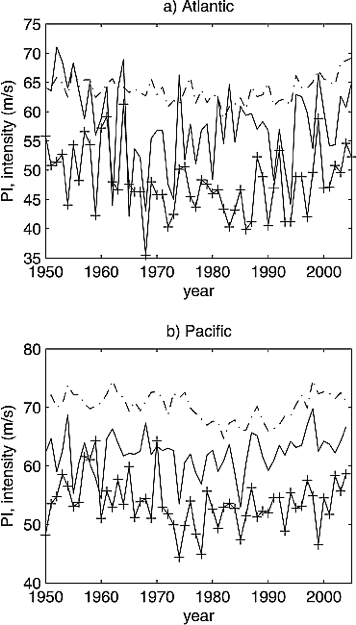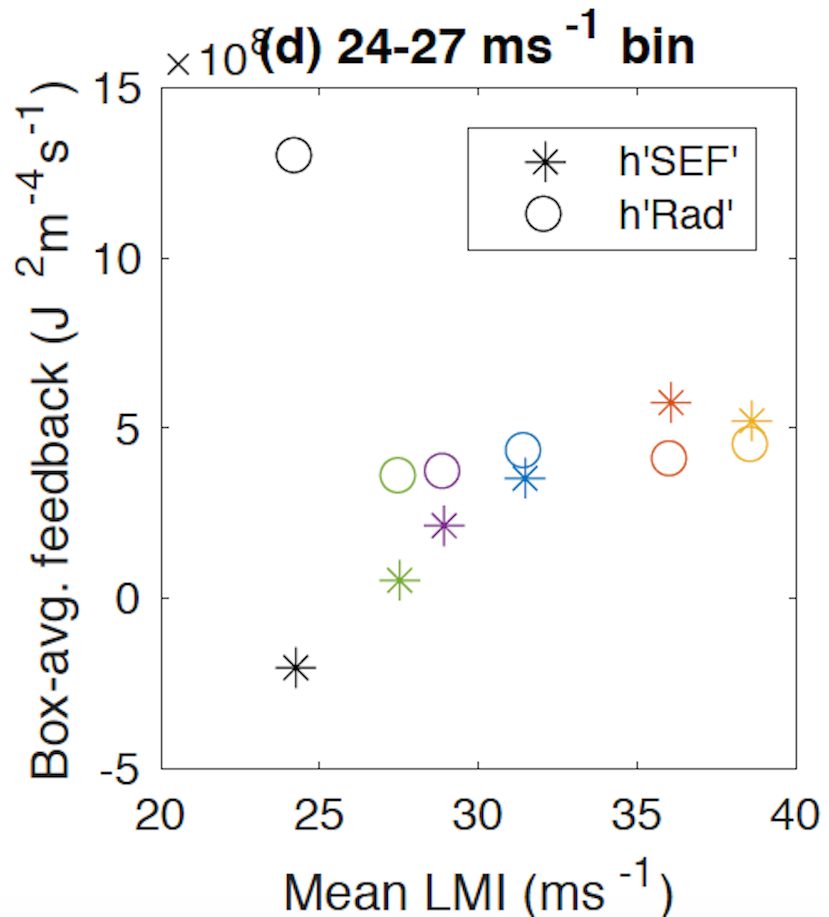Tropical Cyclone Intensity

Understanding the cause of observed trends in tropical cyclone (TC) intensity and projecting future changes is a topic of great interest and importance. There is some evidence that tropical cyclone intensity has already changed, such as an increase in the power dissipiation of North Atlantic trpoical cyclones and an increase in the intensities of the strongest tropical cyclones. The thermodynamic theory for the physics of a mature tropical cyclone tells us that the cyclone’s intensity cannot exceed an upper bound, the potential intensity (PI), which is determined by the sea surface temperature and profile of atmospheric temperature and humidity. The potential intensity is expected to increase in a future, warmer climate. We analyze trends and variability on potential intensity and actual tropical cyclone maximum intensity using observations.
Some of our previous work has shown that observed interannual variations of maximum TC intensity are consistent with the predictions of PI theory. Modest fractions of the variance in actual intensity are explained by PI variations. This is shown in the figure on the left, from Wing et al. (2007), where the crosses indicate actual TC maximum intensity and the solid line indicates the PI. Much of the interannual varation in PI experienced by the storms comes from variation in TC tracks, so that the storms in different years are more or less likely to smaple regions of high PI, rather than from variations in PI at a fixed location. In a global analysis, we found that potential intensity has the strongest year-to-year relationship with actual TC intensity in the West Pacific. Correlations between actual hurricane intensities and potential intensity improve over longer time periods, highlighting how the theory can inform changes in hurricane intensity over sufficiently long periods (longer than a few years, to decadal and multi-decadal time scales). We also are examining the factors affecting trends and variability in tropical cyclone potential intensity itself; both sea surface temperatures and lower stratospheric temperatures contribute.
Process-Oriented Diagnostics of Tropical Cyclones in Climate Models
We also are exploring tropical cylogenesis and intensification processes in historical simulations with high-resolution climate models, including both coupled and uncoupled configurations. We track the formation and evolution of tropical cyclones in the climate model simulations and apply our analysis both along the individual tracks and composited over many tropical cyclones. Our analysis framework includes diagnostics that reveal the physical processes responsible for a good simulation of tropical cyclones. hese diagnostics help us identify sources of model biases and target areas for improvement. We have found that feedbacks involving surface wind speed and surface enthalpy fluxes tend to be stronger in models that simulate more intense tropical cyclones, and that in all models, radiative feedbacks contribute positively to TC intensification (see the figure to the right). This indicates that the representation of the interaction of spatially varying radiative cooling and surface fluxes with the developing TC is partially responsible for inter-model spread in simulated TC intensity. We are continuing to apply these diagnostics to a broader set of models and are working to create a "reference" from observations.
There is increasing evidence that tropical cyclone development is accelerated by cloud-radiative feedbacks. We find that a stronger cloud-radiative feedback, is associated with faster intensification rates. We continue to investigate the role of cloud-radiative feedbacks in TC intensification across a hierarchy of models and in satellite observations.

Papers on this topic
- TC Intensity
- Wing, A.A. (2021): Acceleration of tropical cyclone development by cloud-radiative feedbacks, J. Atmos. Sci., in review.
- Ruppert, Jr., J.H., A.A. Wing, X. Tang, and E.L. Duran (2020): The critical role of cloud-infrared radiation feedback in tropical cyclone development, Proc. Nat. Acad. Sci., 117, 27884-27892, doi:10.1073/pnas.2013584117.
- Shields, S., A.A. Wing, and D.M. Gilford, (2020): A global analysis of interannual variability of potential and actual tropical cyclone intensities, Geophys. Res. Lett., 47, e2020GL089512, doi:10.1029/2020GL089512.
- Sobel, A.H., S.J. Camargo, T.M. Hall, C.-Y. Lee, M.K. Tippett, and A.A. Wing (2016), Human influence on tropical cyclone intensity, Science, 353, 242-246, doi:10.1126/science.aaf6574.
- Wing, A.A., K. Emanuel, and S. Solomon (2015), On the factors affecting trends and variability in tropical cyclone potential intensity, Geophys. Res. Lett., doi:10.1002/2015GL066145.
- Wing, A.A., A.H. Sobel, and S.J. Camargo (2007), Relationship between potential and actual intensities of tropical cyclones on interannual time scales, Geophys. Res. Lett., 34, L08810, doi:10.1029/2006GL028581.
- TCs in Global Models
- Moon, Y., D. Kim, A.A. Wing, S.J. Camargo, M. Zhao, R. Leung, M.J. Roberts, D.-H. Cha (2021): An evaluation of tropical cyclone rainfall structures in the HighResMIP simulations against satellite observations, J. Climate, in review.
- Jones, E., A.A. Wing and R. Parfitt (2021): A global perspective of tropical cyclone precipitation in reanalyses, J. Climate, 34, 8461–8480, doi:10.1175/JCLI-D-20-0892.1.
- Moon, Y., D. Kim, S.J. Camargo, A.A. Wing, K.A. Reed, M.F. Wehner, and M. Zhao (2020): A new method to construct a horizontal resolution-dependent wind speed adjustment factor for tropical cyclones in global climate model simulations, Geophys. Res. Lett., 47, e2020GL087528, doi:10.1029/2020GL087528.
- Camargo, S.J, C.F. Giulivi, A.H. Sobel, A.A. Wing, D. Kim, Y. Moon, J.D.O. Strong, A.D. Del Genio, M. Kelley, H. Murakami, K.A. Reed, E. Scoccimarro, G.A. Vecchi, M.F. Wehner, C. Zarzycki, and M. Zhao (2020): Characteristics of model tropical cyclone climatology and the large-scale environment, J. Climate, 33, 4463–4487, doi:10.1175/JCLI-D-19-0500.1.
- Moon, Y., D. Kim, S. J. Camargo, A. A. Wing, A. H. Sobel, H. Murakami, K. A. Reed, E. Scoccimarro, G. A. Vecchi, M. F. Wehner, C. M. Zarzycki, and M. Zhao (2020), Azimuthally averaged wind and thermodynamic structures of tropical cyclones in global climate models and their sensitivity to horizontal resolution, J. Climate, 33, 1575–1595, doi:10.1175/JCLI-D-19-0172.1.
- Wing, A.A., S.J. Camargo, A.H. Sobel, D. Kim, Y. Moon, H. Murakami, K.A. Reed, G.A. Vecchi, M.F. Wehner, C. Zarzycki, and M. Zhao (2019), Moist static energy budget analysis of tropical cyclone intensification in high-resolution climate models, J. Climate, 32, 6071–6095, doi:10.1175/JCLI-D-18-0599.1.
- Maloney, E.D., A. Gettelman, Y. Ming, J.D. Neelin, D. Barrie, A. Mariotti, C.-C. Chen, D. R. B. Coleman, Y.-H. Kuo, B. Singh, H. Annamalai, A. Berg, J.F. Booth, S.J. Camargo, A. Dai, A. Gonzalez, J. Hafner, X. Jiang, X. Jing, D. Kim, A. Kumar, Y. Moon, C.M. Naud, A.H. Sobel, K. Suzuki, F. Wang, J. Wang, A.A. Wing, X. Xu, M. Zhou (2019), Process-oriented evaluation of climate and weather forecasting models, Bull. Amer. Meteorol. Soc., 100, 1665–1686, doi:10.1175/BAMS-D-18-0042.1.
- Kim, D., Y. Moon, S.J. Camargo, A.A. Wing, A.H. Sobel, H. Murakami, G.A. Vecchi, M. Zhao, and E. Page (2018), Process-oriented diagnosis of tropical cyclones in high-resolution GCMs, J. Climate, 31, 1685-1702, doi:10.1175/JCLI-D-17-0269.1.
- Camargo, S.J. and Wing, A.A. (2016),Tropical cyclones in climate models, WIREs Clim Change, 7, 211-237, doi: 10.1002/wcc.373.
News on this topic
- Interviews
- Why atmospheric science matters. Interview with Columbia Alumni Association.
- Video interview on hurricanes and climate change. Video interview with The Climate Scientist.
- FSU researcher seeks errors to improve hurricane predictions in climate models. 16 September 2018. WCTV.
- Getting a boost: Hurricanes are becoming stronger and wetter with climate change. 18 November 2020. FOX 46 Charlotte.
- FSU Meteorology Professor Receives NASA Award. 11 May 2021. WCTV.
- News Articles
- Editors' Choice In Other Journals: Birth of a storm. 13 Nov 2020. Science, 270 (6518), 806-807.
- Research: ’Cloud greenhouse effect’ can help tropical cyclones develop. 28 October 2020. WCTV.
- Tropical cyclones on track to grow more intense as temperatures rise. 14 July 2016. LDEO News.
- FSU researcher rooting out the errors in storm simulation models. 11 September 2018. FSU News.
- Rooting out the errors in climate models to better predict hurricanes. 13 September 2018. State of the Planet Blog of the Earth Institute at Columbia University.
- Hurricane Simulations Help Facilitate Forecasts and Enhance Preparations. March 2020. FSU Research Computing Center Spotlight.
- Greenhouse effect of clouds instrumental in origin of tropical storms. 26 October 2020. FSU News.
- Greenhouse effect of clouds instrumental in origin of tropical storms. 26 October 2020. Penn State News.